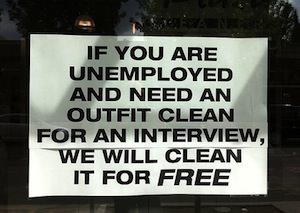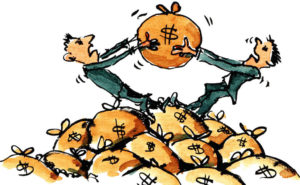Unemployment IS Down: When Good News Really Isn’t
Those who were heartened by the recent drop in the unemployment rate have less to cheer about than it seems as the gap between those with jobs, and those who have given up, yawns widely. The percentage of working-age Americans with jobs is still painfully low -- and not likely to change soon as corporations hoard cash.
At first blush, the new unemployment numbers hint of good news. The national rate dropped from 7.3 percent in October to 7 percent in November, with 203,000 added jobs. Of course, those numbers fail to illustrate what’s really happening: an economic recovery that has done little for the millions of people tossed out of work during the Great Recession.
The New York Times has a series of short analyses of what the numbers mean, and it’s illuminating to read them in succession, beginning with Binyamin Appelbaum’s counterintuitive argument that a higher unemployment rate would have been better news, since the rate measures only those looking for work. It doesn’t count those who quit looking out of resigned hopelessness. He writes:
It’s easier to see the trends if you skip over the government’s wacky data for the month of October, and compare November with September. The number of people that the government counted as unemployed fell by 348,000, driving the unemployment rate from 7.2 percent to 7.0 percent. But the number of people with jobs only increased by 83,000. In other words, for every person who found a job between September and November, three other people stopped looking.
Explanations for this problem fall into two categories, both depressing.
The first school holds that the economy is broken: We have entered an era of “secular stagnation.” We must resign ourselves to a smaller work force.
The second school holds that the government is broken. There are steps we could take to grow faster but, for the most part, we are doing the opposite.
This sounds more promising, but some subscribers to the second school add an important caveat. They warn that as time passes, problems that could have been fixed calcify into enduring realities. People who might have returned to the work force fall back on disability benefits, or simply begin to lose necessary skills.
Workers’ paychecks are a little bigger, which is always welcome news. But as Floyd Norris points out, the dearth of jobs is stunning:
The unemployment rate fell to 7 percent in November, the Labor Department says. It was 5 percent in December 2007. The total number of jobs rose 203,000 to 136,765,000. That is still 1,271,000 less than the peak, reached in January 2008. The number of unemployed workers fell below 11 million for the first time since late 2008. It was 7.6 million at the end of 2007.
But one indicator is back to pre-recession levels. The number of people who have been out of work for less than five weeks fell to 2,461,000. That is the lowest figure since April 2007. As I noted in my Off the Charts column last week, it is long-term unemployment that is the biggest problem now. The number of people out of work for more than six months is 4,066,000. That is down 2.6 million from the peak, but before the Great Recession the figure had never been as high as three million.
Through all the recessions of the post-World War II period, the share of unemployed who had been jobless for at least six months exceeded 25 percent once, in 1983, prior to this cycle. Now it is 37 percent, down from a peak of 45 percent.
What that means is people losing jobs now are finding new ones fairly quickly. But the longer people have been out of work, the less likely they are to get hired, signaling yet another American divide between those whom hiring directors will take on, and those forced outside the working economy. In fact, from 2003 until the start of the recession in 2007, the percentage of the working-age population with jobs bounced around the 62 percent range. In November it was 58.6 percent. That gap reflects the millions of Americans the recovery left behind, augmented by the underemployed — people who held good-paying full-time jobs now working one or two part-time jobs, without benefits, for much lower wages.
Wall Street? Well, it and the cash-hoarding big corporations are still in record territory.
—Posted by Scott Martelle.
Your support matters…Independent journalism is under threat and overshadowed by heavily funded mainstream media.
You can help level the playing field. Become a member.
Your tax-deductible contribution keeps us digging beneath the headlines to give you thought-provoking, investigative reporting and analysis that unearths what's really happening- without compromise.
Give today to support our courageous, independent journalists.





You need to be a supporter to comment.
There are currently no responses to this article.
Be the first to respond.